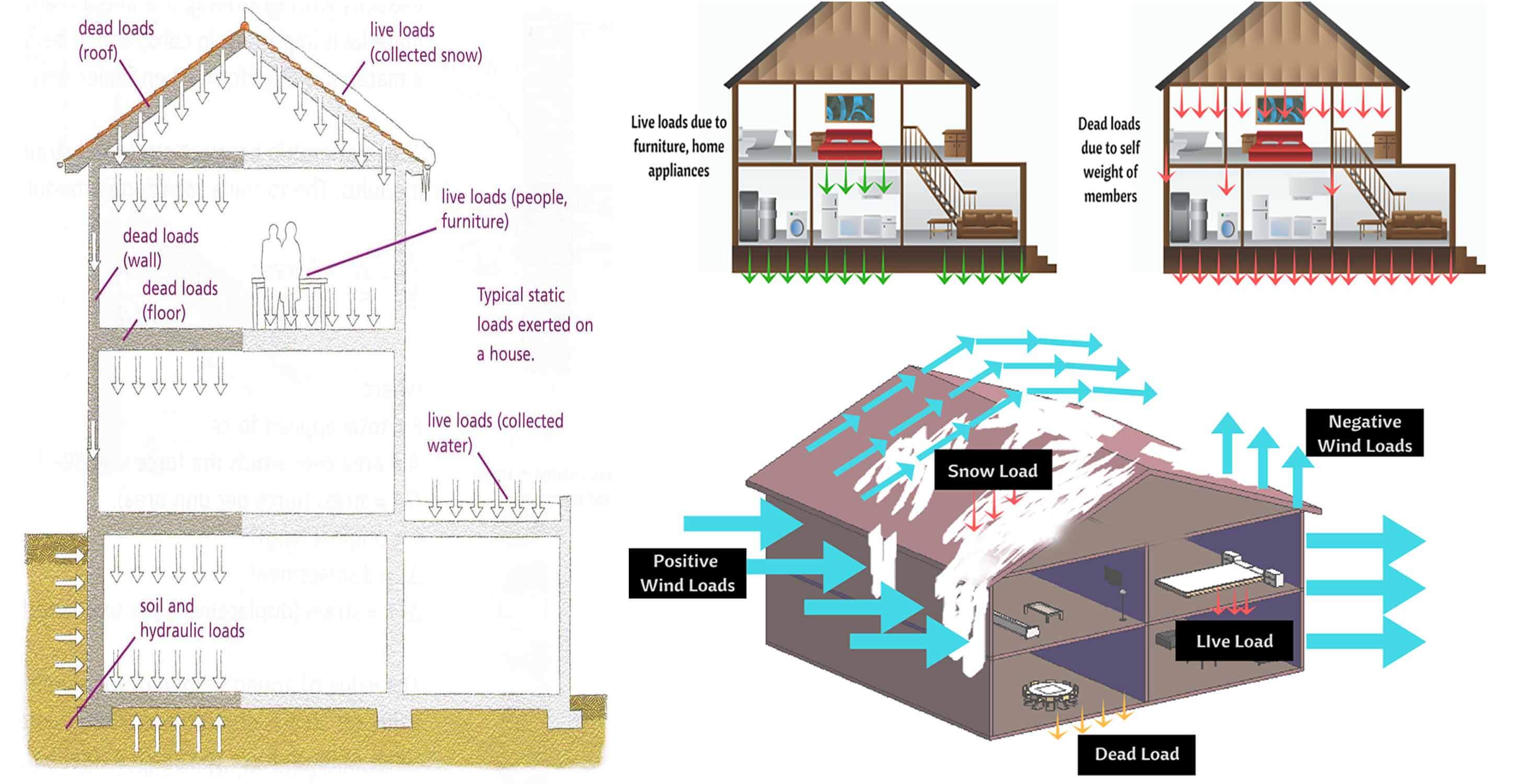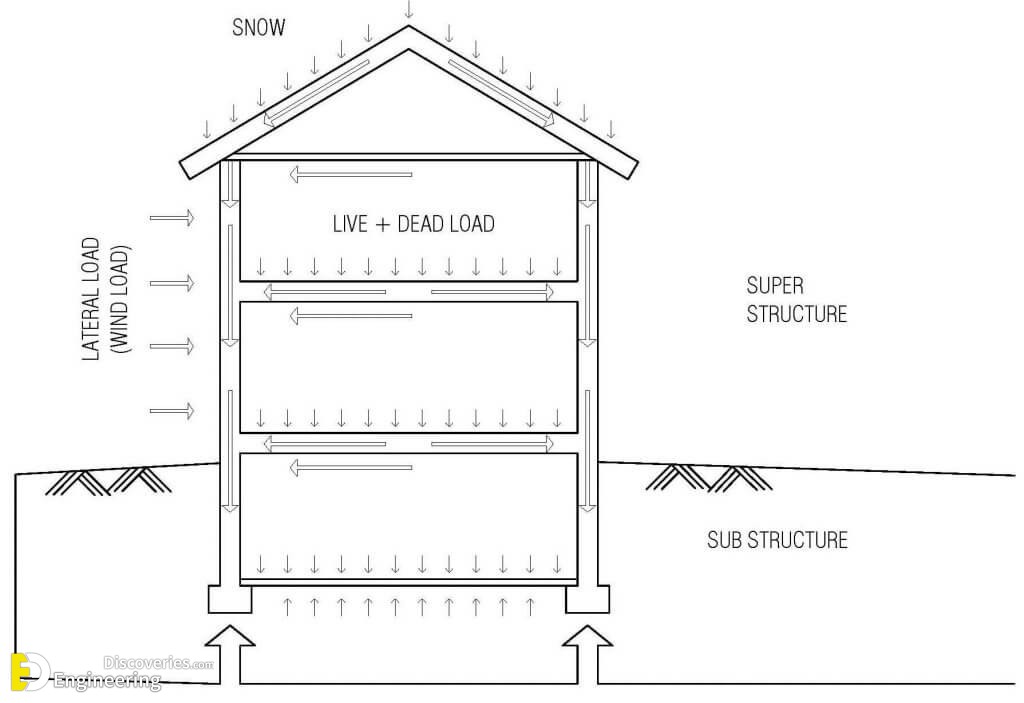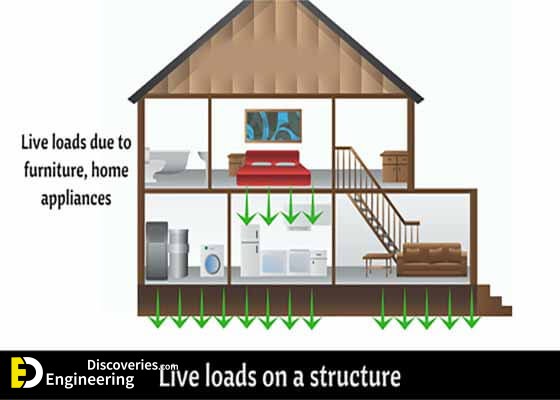Structural analysis is a very important part of a design of buildings and other built assets such as bridges and tunnels, as structural loads can cause stress, deformation and displacement that may result in structural problems or even failure. The building regulations require that structures must be designed and built to be able to withstand all load types that they are likely to face during their life cycle. There are a number of different types of load than can act upon a structure, the nature of which will vary according to the design, use, location and materials being used. Design requirements are generally specified in terms of the maximum loads that a structure must be able to withstand. The different types of loads acting on a structure are broadly classified into following
Dead Loads
These loads are permanent loads which are carried to the structure throughout their lifespan. Dead loads are also called as stationary loads. These loads occur mainly due to the self-weight of the structural members, fittings, fixed partitions, fixed equipment, etc. For suppose, to build a column we need steel bars, concrete, shuttering, etc.
Well, concrete and bars are fixed members of the structure which are available throughout their lifespan whereas shuttering is a temporary member, which is used to keep concrete in the desired position. Shuttering is taken off from the structure after curing. From above, concrete and steel bars self-weights are considered as a dead load and load of a shuttering is not.
Live Loads
As the name itself resembling that these type of loads are real-time loads. Live loads are also called as imposed or sudden loads. Live loads changes with respect to time. This type of loading may come and go. For example, At one moment the room may be empty hence the live load is zero. If the same room is packed with the people, then the live load intensity will vary considerably. The live load includes the weight of furniture, people occupying the floor, etc.
Snow loads
This type of loads is considered only on the structure which receives snowfall during monsoon. Snow loads are calculated by the projections made by snow at different parts of the structure, The amount of snow load depends on the height of building, size & shape of the roof, the location of building whether it’s on the slope or not, the frequency of snow etc. The more details about snow loads are clearly mentioned IS 875 (part 4) – 1987.
Wind loads
This types of loads are considered in design if the height of the building is more than 15m. Wind loads are occurred due to the horizontal load caused by the wind. As an increase in using lighter materials in the construction, wind load for a building should be considered. The structure should be strong enough with the heavy dead weights and anchored to the ground to resist this wind load. If not, the building may blow away. Wind load acts horizontally towards roofs, walls and create
Earthquake loads
These type of loads causes movement of the foundation of structures. Earthquake forces are internal forces that developed on the structure because of ground movements. Three mutually perpendicular forces act on the structure during an earthquake, two horizontal forces which acts in opposite direction and one vertical force due to the weight of the structure. As vertical force doesn’t affect much during earthquake whereas two opposite horizontal forces results in movement of the building during an earthquake. These two horizontal direction forces are considered in the design. Due to inertia, additional forces on the structure develop on the superstructure. The impact of an earthquake on structure depends on the stiffness of structure, soil media, location and height of the structure. Accordingly, the earth has been divided into several zones depending on the magnitude of an earthquake. Consider an example of Japan which is prone to frequent earthquakes. Japan lies in a severe earthquake zone in the world. At this place, earthquake forces are strictly taken into consideration while designing a structure.
In order to compute the seismic forces acting on a structure is deduced by computing one of the below-mentioned methods.
1- Response spectrum method
2- Seismic coefficient method.
Thermal loads
All materials expand or contract with temperature change and this can exert significant loads on a structure. Expansion joints can be provided at points on long sections of structures such as walls and floors so that elements of the structure are physically separated and can expand without causing structural damage.
Settlement loads
Stresses can occur in buildings if one part settles more than another. A flexible structure will be able to accommodate the small stresses, whereas a stiff structure will need careful design to alleviate the more severe stresses that may be exerted.
Some other types of loads
Some other types of forces or loads that act on the structure which are taken into account in case they are liable to affect materially the safety or serviceability of structure:
1- Foundation movement (IS 1904)
2- Erection load (IS 875- Part2)
3- Vibration, Fatigue
4- Soil and fluid pressures (IS 875- Part5)
5- Stress concentration effect due to point of application of load and the like.









